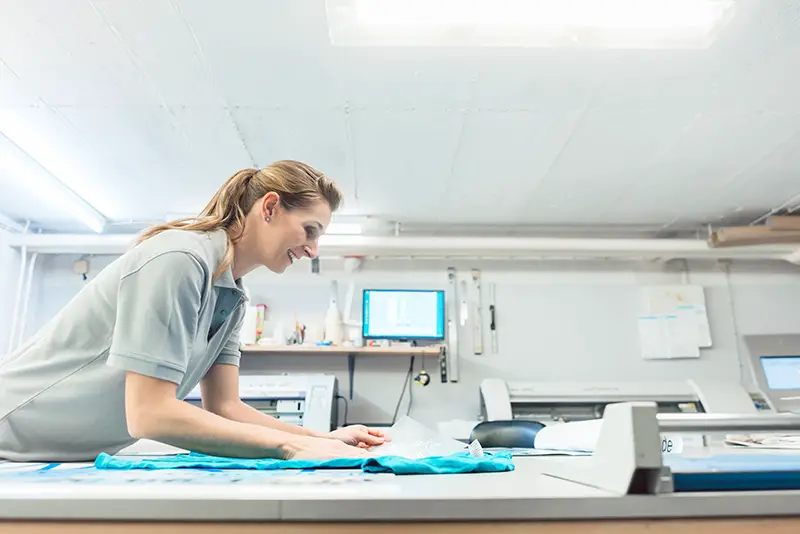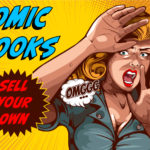Want to turn your digital creative skills into a side-hustle and earn some extra money? While this post is aimed at side-hustles many of these ideas can ultimately be scaled up or combined into a full-time income.
If you have skills in digital creative applications, there are plenty of opportunities to turn these into income as a side-hustle. There are many online marketplaces out there selling customizations, print-on-demand products, templates and artwork. Alternatively, set up your own online store.
If you find the ideas in this post interesting but you’re not sure which one is right for you then, make sure to read my post How to Choose a Creative Side Hustle: Step-by-Step Guide.
Let’s get started looking at the possibilities…
Stock Photos, Images and Videos

With more and more content being generated and published online every day there is strong demand for stock images and videos. If you’re skilled then you can earn a significant income and some do this as their full-time occupation.
There are a lot of stock image marketplaces but most will have some criteria for entry where you will need to demonstrate a back-catalogue or portfolio of your work. This is to maintain the quality of their platform.
Once accepted, you will be able to license your images to customers and receive a cut of the price as a royalty, whist still retaining ownership. You can set your own license terms to restrict what the images are allowed to be used for.
Agreeing to exclusivity can also increase the amount of the royalties received and this can also be increased on some platforms by having a good sales record. This aims to reward committed sellers.
Popular Marketplaces:
Royalty amounts are correct at time of writing but check the marketplace websites for up to date payment info.
- Adobe Stock – Earn 33% royalties on photos, vectors and illustrations and 35% on videos. Adobe also has a tiered bonus program including rewards such as free software subscriptions based on sales.
- Getty Images – contributors must agree to their content being exclusive to Getty Images. Content is most commonly licensed as royalty-free with unlimited use and the rates are 20% for images and 25% for videos.
- iStock – owned by Getty Images. Royalties are from 15% for photos and 20% for videos and illustrations although this rises to 25-45% if exclusive.
- Shutterstock – royalties vary according to sales each calendar year. Images and videos are both at 15-40% but with a differing number of sales for each tier.
Stock Fonts / Typefaces
So this one requires real attention to detail and can get quite technical. Making sure the quality of your work is top-notch will help significantly in getting accepted as a creator on the various platforms. There is no room for sloppiness here. Check out some of the more popular platforms below but be aware that selling fonts is difficult to earn a decent income from.
Popular Marketplaces:
Digital Customizations
As more smart devices hit the market, they typically feature some kind of display. Manufacturers often launch a marketplace for selling customizations and sometimes open them up to third-party sellers. I would consider this as a growth area to pay attention to, although the devices that offer this capability are fairly limited at the moment.
Watch Faces
Smart watches are becoming more popular and more advanced. Just have a look at the new Apple Watch or Garmin. Most smart watches allow customization of their watch faces. Each platform varies from requiring coding knowledge to purely design skills.
Some marketplaces take care of all the payment side of things and some just allow you to host your creations and provide a link to your own payment methods.
Check out my post How To Sell Apple Watch Faces and Other Brands for a more detailed explanation of how to get started selling watch faces and how much you can earn.
Cell Phone Wallpaper
Selling cell phone (mobile phone for our British readers) wallpapers is potentially one of the least labor-intensive ways to make money on our list. If you’re already generating designs for one of the other items on this list such as Print-On-Demand products then this is a simple repackaging of your design and throwing it on Etsy or other marketplace.
…don’t make this the center of your new business plan but it is a good way to squeeze out that extra revenue from each design…
One thing to note is that this market has declined substantially over the last decade when wallpapers were big business. It is now so easy to get free wallpapers or just for customers to use or produce their own. So don’t make this the center of your new business plan but it is a good way to squeeze out that extra revenue from each design that you produce for little time investment.
You must be careful here with image licensing as reselling a stock image as the core part of a digital product is not allowed. You would be best advised to take your own photos or create your own illustrations.
Etsy is a great marketplace for selling wallpapers since they are likely small spontaneous purchases where the idea matters more than the execution. You can capitalize on Etsy’s customers browsing other products and making their way to your wallpapers rather than the more unlikely scenario of someone specifically seeking out a dedicated website for wallpapers.
Templates

Downloading a template to showcase a product, website or other creation is typically a great time-saving method for designers or marketing agencies. They may also lack the skills to create it themselves so have no other option. Either way, the use of templates is on the rise and is a great way to earn some extra income.
Product Mockups
As the popularity of print-on-demand products grows, publishers need mockups of products if they cannot physically print and photograph each one. Creating a visually-appealing context for the product and then using smart objects allows your customer to swap in their own logo or artwork which will then wrap to the featured product.
This creates a cost and time-efficient way to showcase a PoD or other product that has a large number of potential customizations.
There a number of marketplaces to sell product mockups, each with their own target markets and pros and cons. For a more in-depth guide, along with typical earnings, check out my post Where To Sell Mockups.
Website Mockups
Similar to product mockups but with websites. They can be functional prototypes or image templates for marketing.
Mockups for Marketing
Website mockups for marketing purposes typically include a photo of a real life scene featuring phones, tablets and computer screens with smart objects that allow a customer to drop in an image of their website or app. These are used to provide a context for the app or website rather than any function and are perfectly suited to those handy with Photoshop.
Selling these types of mockup are very similar to those for products so, I suggest having a look at my post on product mockups, Where To Sell Mockups since, there is a large overlap in the process and sales platforms used.
Working Prototype Mockups
Website mockups for prototyping can range from having a strong technical bias to a graphical one or somewhere in between. They are essentially prototypes of a full website but vary fro purely visual to semi-functional.
Those made in Adobe XD will reward a talented graphic designer yet also pack in the functionality. They offer an end to end solution so can be picked up by developers for the next stages of website creation.
Alternatively, you could make purely graphical prototyping mockups in Photoshop or Illustrator which will show the visual layout and assets for each page of the site. These typically end up as a set of pdf files.
Your creations can either be sold on marketplaces or you can approach agencies that specialize in this type of product.
Sell Sheets and Brochures
You may have never heard of the term Sell Sheet or Sale Sheet before but you’ll have seen them everywhere and the name is pretty self-explanatory. Also known as Product Sheets, they are essentially one-page documents that summarize the benefits and details of a product in an effort to sell it to a customer.
They require strong visual impact and the ability to present key information in a concise and efficient way. You can also expand your creation into a full brochure template as well.
If your skills sit in Graphic Design then Sell Sheets and Brochures might be for you.
Graphic River and Creative Market are two popular places to sell these types of template.
After Effects Animations
Adobe After Effects templates are products that just simply put, look cool. They are visual effects that can be inserted into a customers video project as-is, such as an explosion, or one that they can customize by swapping in their own logo.
With easier access to cameras and video editing software for the general public than ever before After Effects templates continue to gain in popularity. Typical applications are YouTube channel intros or amateur film makers seeking to add more effects or more professionalism to their creations.
When creating After Effects Templates you should include clear instructions on usage as this will help create return customers and a good reputation as a seller.
Where to Sell:
- FilterGrade – They have a great tutorial on how to create templates and start selling on their site here.
- Video Hive (part of Envato)
- Creative Market
- RocketStock – owned by shutterstock
- Motion Array
- Pond5
- Storyblocks
Logo Design
Generating logos specifically for stock marketplaces or selling unused creations from other projects is a good way to generate some extra income. There are a large number of platforms to sell on, many of which are the usual big players that sell pretty much any creative asset but some of them are specifically tailored to logos.
Obviously, to sell stock logos you should be offering editable vector files to allow the customer to insert their own company name.
When it comes to deciding what logos to design, thinking about different types of business niche is very useful and will enable you to design a more specific logo that might suit a particular customer rather than something very generic that will not stand out from the competition.
Another option is to design logos that may be centered around the first letter of a brand name. It is also a good idea to offer a number of different color combinations of each logo, either a separate listing or as part of a bundle.
Where to Sell:
- Shutterstock – You know who they are. Mixed quality logos.
- VectorStock – High-quality vector logos sold for credits, one-off fee or a subscription
- Graphic River – Very high-quality logos selling at a high price-point
- Creative Market – Massive variety of logos sold on their own or in bundles
- BrandCrowd – Sell your unused logos to BrandCrowd who then turn these into templates in their logo designer for customers to purchase. Logos you sell must be unsold and exclusive to BrandCrowd.
- Your own site or social media account – embed a store such as Sellfy or Shopify and sell logos directly. This will of course require an existing following or some marketing by yourself.
Artwork

If you have the skills to create digital artwork then chances are that you love doing it as a hobby. So why not also earn money from it and share it with the world.
It will be helpful if you already have an online presence or following as you can drive traffic to your store or marketplace link. For a more detailed look on how to get started earning money from your digital art, head over to my post How to Start a Digital Art Side-Hustle.
Something to also consider is whether you should sign your artwork and the pros and cons that can bring. Check out my post Signing Digital Art: Should You Do It? for more advice on that.
Sell Art Prints
Selling prints of your artwork (I’m talking physical prints, not downloads here) is a great way to earn some side income and there are a variety of ways to do this. You can either take care of the printing yourself and hold stock which, you ship when you receive an order, or you can use a Print on Demand service either as an integration into your own site or a list on a dedicated marketplace.
Art Marketplaces
- Art Web – These guys will take care of printing via their publishers and selling is free. Art Web is not always open to new artists to check back regularly if you’re unlucky.
- Saatchi Art – Iconic art brand. Working with a professional printer they offer open edition prints which are unlimited in number. If you wish to sell a limited number then you will need to print and ship to customers yourself.
- Design by Humans – More of a Print in Demand type of marketplace which sells art prints as part of their product range. Artists are vetted for the quality of their work so the products on offer feature high-quality designs.
- Etsy – Integrate with a third-party service such as Printful or Printify to print on demand for your customers.
There are also other marketplaces to sell prints which are more focused on general Print-On-Demand products. For more details on Print-On-Demand see the PoD section for more details.
Your Own Website
Selling on your own website is a great way to stay in control of the interaction with your customers. Using a marketplace as an intermediary typically means that you do not know who your customers are and cannot contact them.
When using your own website you have the opportunity to maximize every interaction and stay in contact with your customers…
When using your own website you have the opportunity to maximize every interaction and stay in contact with your customers if they opt in to future communications. This may mean future sales but at the very least you can build a following and a community if that interests you. You also get to keep 100% of your profits.
The difficulty with selling from your own site is that you will need to drive customers to it yourself. This may be by building up a reputation either online or offline or running ads on social media for example.
Once you have your site you’ll be pleased to know that there are a number of services that you can embed on it to take care of the e-commerce side of the business. Some of the more popular e-commerce integrations are Shopify and Sellfy.
These allow you to either print yourself to stock which is likely what you would do for limited editions where each print is numbered. Alternatively, you can integrate a print-on-demand service such as Printful or Printify to take care of printing and shipping.
Social Media
If you already have a following then it makes sense to try and capitalize on it. Each social media platform has their own rules but increasingly more nowadays, they are making it harder to access your audience directly or to send traffic off to another website.
If you build a following on social media and rely on this directly to sell your work then you have to realize that your income is at risk since you do not own the access to your customers.
Social media platforms are fantastic to gain awareness of your work but I would suggest having your own site or an account on a marketplace that you can drive customers over to.
Sell Art as NFTs
Relatively new, Non-Fungible Tokens (NFTs) are a way to certify a piece of digital art so that there is only one “original”. This can then be sold and resold. NFTs need to be created using a crypto currency called Ethereum so you’ll need to buy some of that first.
There are a variety of platforms that will then create and sell your NFT but there are several confusing fees that the artist will need to pay along the way which make lower-priced artwork potentially lose money.
You must pay careful attention to the sale price you choose and the numerous fees!
So in summary, NFTs are not necessarily as attractive as they have been portrayed in the media.
Commissions
In this context, commissions are bespoke pieces of art that have been ordered by customers to meet their requirements. Whilst potentially very profitable, you will need to put some work in to gain exposure and attract these commissions.
This will typically be posting your work on forums or Behance until you have a reputation but you can also try listing your services as a freelance artist (see the freelance section down below). You will need enough good quality work in your portfolio to establish yourself as a credible artist so concentrate on building this if commissions is something that interests you.
Print on Demand

In case you’re unaware what Print on Demand (PoD) is, I’ll explain. A creator, such as you or me, can upload a design, typically a logo or other digital design, to one of the many PoD marketplaces. You can then select which of the marketplace’s many physical products that you wish your design to appear on. This may be mugs, clothing or stationary and now there are even 3D printing PoD services available!
Once through an approval process, your product will be listed on the marketplace and customers can place an order. Only at this point will a product be produced, with the marketplace printing your design onto their stock products and then shipping it to the end customer. For this service the marketplace will take a cut of your sale price, any other deductions and then pay you the rest.
The benefit of PoD over traditional printing onto merchandise is that you, as the creator, do not need to manage the printing process, buy or hold any physical stock. It is a fantastic way to make money as a digital creative but as a result, has become very saturated with other creators. Your designs will need to be truly unique and also targeted to what customers are searching for to succeed.
Whilst listing on a marketplace can mean that you do not need to market your products externally as much as you would with your own website, they are very competitive. It is always a good idea to market your stores to keep sales constantly coming in or you risk just getting lost in the thousands of similar product listings.
So now that you understand the concept of PoD let’s talk about some of the different marketplaces for selling your designs.
Where to Sell Print on Demand Designs
There are a good selection of print-on-demand marketplaces, each with their own benefits and products. Unless the terms of a specific platform require exclusivity then there is nothing stopping you from listing your designs on more than one of them.
| Marketplace (M) /Supplier (S) | Products Offered |
|---|---|
| Merch by Amazon (M) | Clothing, PopSockets, Phone Cases, Tote Bags, Throw Pillows |
| Redbubble (M) | 70+ unique products including: Clothing, Pillows, Stickers, Posters, Wall Art, Phone Cases, Home Decor, Accessories, Stationary, Gifts |
| Zazzle (M) | Clothing, Shoes, Home Decor, Stickers, Invitations & Cards, Stationary, Gifts, Wrapping Paper, Phone Cases, Accessories, Wall Art, Toys and Games |
| Society6 (M) | Wall Art, Home Decor, Furniture, Bed & Bath, Stationary, Clothing, Accessories, Lifestyle |
| Design by Humans (M) | Clothing, Phone Cases, Stickers, Accessories, Art Prints, |
| TeeSpring (M) | Clothing, Stickers, Phone Cases, Pop Sockets, Home Decor, Accessories |
| TeePublic (M) | Clothing, Home Decor, Stickers, Phone Cases, Wall Art, Accessories |
| Shapeways (M) | 3D printed products |
| Printful (S) | Clothing, Custom Embroidery, Phone Cases, Accessories, Home Decor, Wall Art, Stationary |
| Printify (S) | Clothing, Custom Embroidery, Phone Cases, Accessories, Home Decor, Wall Art, Stationary |
Merch by Amazon
Merch by Amazon is the largest platform for T-shirts, Sweatshirts and Hoodies (so basically Merch then!) and is a good choice for a couple of reasons. Firstly, it gets a very large amount of traffic and secondly your products can appear in regular Amazon search results.
Merch is quite limited in the range of products that it offers when compared to other PoD platforms however, but the profits can be significantly larger due to the larger customer base.
Merch by Amazon does have a lot more competition in terms of designers and restricts the number of products that you can list until you work your way up a tiered system based on sales performance.
For details on their royalty rates have a look at the Merch by Amazon site here.
Redbubble
Redbubble is one of the more popular marketplaces with artists for Print on Demand and has a good variety of products (70+). They also offer good quality products and cater to an international customer base instead of just the United States.
Redbubble also give creatives a bit more freedom and do not restrict the amount of listings. The size of their customer base is not huge when compared to Merch by Amazon and Zazzle but they are a solid platform to consider.
Redbubble are very good at SEO and get a lot of organic search traffic for product listings through search engines. They also have a fan art program where designs can be submitted for approval by the license-holder and then listed.
Zazzle
Another big market player, Zazzle has a massive range of products including shoes, baby clothes, puzzles, electronics, wrapping paper and invitations, along with the usual offerings of t-shirts, hoodies, etc.
Zazzle allow you to set your own royalty rates between 5% and 99% like some other platforms but this will be added onto the base costs. You need to keep an eye on what other sellers are pricing their products at to ensure you stay competitive.
Society6
Society6 has a strong focus on artists, both emerging and seasoned. Artwork quality is high and they also treat artists with respect. The have a strong focus on home decor products.
Although one of the smaller players, Society6 has an excellent range of products and even offers furniture.
The commission rate for products other than wall art is fixed at 10%.
Design by Humans
Design by Humans is a curated platform offering high-quality designs with a strong focus on not infringing copyright or trademarks.
The product offerings are quite narrow, akin to Merch by Amazon and the commission amounts are reasonable.
Each product has a set amount earned rather than a generic percentage or the ability to choose yourself.
Teespring
Teespring is now known as Spring and focuses mostly on clothing as you might have guessed. They do also sell a variety of additional products such as home decor and phone cases, etc. Their clothing range has a good selection and includes some specialty products such as swimwear, hats and neck gators.
Teespring gives you your own customizable storefront but will steer you to do your own promotion rather than through their marketplace.They also compliment this with the ability to list your products on other stores such as Amazon and eBay with their “Boosted Network”.
Teepublic
Owned by Redbubble, Teepublic is similar to Teespring in that they specialize in clothing but also offer additional products such as wall art, phone cases, stickers and some home decor items. The range of products is limited however, when compared to other marketplaces and the quality of designs on offer is mixed.
As with Redbubble, Teepublic are particularly good at getting designs featured in search engine results. They also have a similar fan art program as well.
Shapeways
Shapeways are one of the few 3D print-on-demand services out there. If you’re a 3D modeller then this is a great option – just open up a store and list your designs. Shapeways will then print the items for you and ship to the end customer as with normal PoD services. A number of materials are available including metal. Open a store on Shapeways here.
For more information, check out my post How to Sell 3D-Printed Products Without a Printer.
Third-Party Supplier Integrations
There are a number of third party suppliers that can be used rather than marketplaces. They offer integrations with non-print-on-demand sites such as Etsy, eBay and e-commerce platforms that integrate into your own website such as Shopify and WooCommerce.
What this means is that you are not restricted to selling on PoD marketplaces and can access a much wider customer base. Once an order is placed on the marketplace, the PoD supplier will print and send directly to the customer. It is similar to a PoD marketplace but a third party is involved.
- Printful – High quality printing, wide range of products, custom embroidery offered. Higher costs. Larger number of e-commerce integrations and fulfillment centers.
- Printify – Cheaper, limited number of e-commerce integrations, less fulfillment centers for international orders, wide range of products.
Products to Sell with Print on Demand
There are a wide variety of products that can have your designs applied to them. Different marketplaces have their own specialisms so if you decide to tailor your design to a particular product then you will need to seek out the marketplace that is right for your product.
The process of creating the design and uploading it to the right platform is basically then same but there some advantages and disadvantages for the types of product on offer that might give you the edge if properly understood.
T-Shirts, Sweatshirts & Hoodies
These types of products were the first to be offered on the big PoD demand marketplaces and hence are the most popular but also the most saturated.
T-shirts are popular year-round and make the most sense to feature your designs. Hoodies and Sweaters can earn more royalties per product as they are more expensive items but are more seasonal.
All-over printing technology is much more available now as well meaning that you can use the entire product as your canvas instead of a centralized logo, character or text. This opens up possibilities such as patterns and large-scale art and is very popular with customers right now. Sweaters, hoodies and leggings are some of the more common products with all-over printing available.
Phone Cases & Pop Sockets
Everyone has a phone and the ability to personalize a case or Pop Socket is extremely popular. Due to the scale of the product you’ll have to create your design with that in mind and avoid very small details that will not be visible on the final product.
Stationary & Wedding Invitations
Stationary is a very large category and can cover everything from notebooks to wedding invitations. Zazzle does particularly well for stationary and lets customers add their own text to your template designs. Don’t overlook stationary since many people make a solid income from their PoD designs. It also has good seasonal stability unlike greetings cards.
Stickers and Magnets
Stickers are a very popular way of monetizing your designs with magnets also being a derivative that is commonly offered. There are cheap to buy for the customer so are a great spontaneous purchase. With the right design can be easier to attract sales than a more expensive PoD item such as a hoodie.
To earn a decent income you will need to make a lot of sales of course, so research is important to make sure that you are making designs that are high quality and what people actually want.
Selling stickers on PoD marketplaces seems to be less competitive than other products so I recommend investigating this if you really want to get into PoD. There can be a lot of very low quality designs out there so make sure you put the effort into quality to make sure you’re more likely to stand out from the crowd. Redbubble is a good marketplace to sell stickers due to its younger customer base.
Mugs
Always popular since they make great gifts and aren’t too expensive. They sell particularly well around during the holidays. Mugs are offered by most PoD marketplaces but not all of them. Merch by Amazon doesn’t include mugs in their product range for example.
Greetings Cards
If you’re a budding greetings card designer then chances are that Zazzle is going to be your best bet to offer these as a PoD product. As with may of their offerings they will turn your designs into editable templates that customers can put their own text on for the ultimate personalized greeting.
Whilst there is year-round demand for birthday cards, customers are only going to buy a single card. That makes this product very seasonal as its holiday greetings cards that will have customers ordering in bulk. A more stable year-round income would be diversifying into wedding invitations.
Wall Art
Wall art can include posters, canvases and tapestries and are offered by many of the marketplaces. If you’re creative skills sit more in art rather than the graphic design then this type of product is probably going to suit you the best. You may also wish to look into specialist art marketplaces as mentioned in the Art Prints section of this post. Wall art is particularly popular with students looking to decorate their dorms on a budget.
Furniture
Furniture is rare in the world of Print on Demand but Society6 offers upholstered furniture that can feature your designs. Since they are ‘big-ticket’ items you only need to sell a small number to make a decent profit but some direct marketing would be a good idea to help drive a bit more traffic and get those sales.
Video Game Assets / Artwork

With so many tools out there for hobbyists to create their own indie games, there is a big call for inexpensive game assets. Typically assets that professionals use will often be made in-house so you’re main target market is likely to be indie game developers or hobbyists.
Where to Sell Game Assets
See below for a variety of the most popular asset marketplaces:
TurboSquid – 3D game assets aimed at professionals. Very high quality models and prices to boot.
Unity Asset Store – Massive store selling all types of game asset. High quality
Unreal Engine Marketplace – Extensive marketplace selling high quality assets of all types
Game Art 2D – Relatively small variety of 2D assets
GameDev Market – General marketplace for most types of game asset.
itch.io – 2D and pixel art assets as part of a wider gaming marketplace
GUI
Whether developing a 2D or 3D game, developers will still require GUI graphics. These are typically 2D static or animated graphic packages for user interfaces, menus, title screens, etc. Check out Game Art 2D and GameDev Market when you’re ready to sell your work.
3D Models
Models of characters and in-game objects are much in demand. It goes without saying that the higher the quality of model, the more you can charge for your work. TurboSquid, Unity Asset Store and Unreal Engine Marketplace are the post popular places to sell these.
3D Scenes
If you’ve created a number of models around a common topic then you might want to also create a scene to put them in, complete with lighting. These can be sold on the same marketplaces as the individual models themselves and if you reference each of them i the descriptions then you increase the potential for more sales as well.
Materials
As computer hardware increases in power, higher quality materials for 3D models will continue to advance. After all, impressive game graphics are only as good as the materials applied to the models.
Character Animations
Character animations are separate from character models themselves in that any model can have an animation applied to it once it is rigged correctly. That means that these can be sold on marketplaces. Motion-captured animations will be the most realistic of course but you may not have access to this kind of technology.
2D Game Assets
2D games have been particularly popular on mobile platforms while their hardware capabilities have been evolving to the point where they can now play 3D games more effectively. This has meant that 2D games have carved out their place in the market.
The most popular assets that developers require will be character sprites, objects and backgrounds. The most popular marketplaces for 2D assets are Gamer Art 2D and GameDev Market.
Pixel Art
A type of 2D game art with its own unique style, pixel art games are big with indie developers mostly for their nostalgic value. They also require much less resource than a 3D game to make so are very accessible.
Assets required for pixel art games will be maps, tilesets, backgrounds, characters, icons and GUI.
Good places to sell pixel art are:
Virtual Goods
If you’re an avid player of video games then no-doubt you’ll know all about micro-transactions. Most items are created by the game developers themselves but sometimes they allow community creators to submit their cosmetic items and earn a proportion of the revenue.
One excellent example of this is the game Warframe from Digital Extremes, which periodically opens up its TennoGen program for submissions by the community of cosmetic objects. If your design is selected it will be included in-game for purchase by players and net you a 30% royalty. See a case study reported by PC Gamer here and the Warframe documentation here.
Check out the Steam Workshop here for more examples and guidance of how to become a creator on Steam, including their revenue share model.
Stream Overlays
Stream overlays are graphics used on top of steamer’s live video used to add more interest and professionalism. Check out any stream on Twitch and YouTube and you’ll see stream overlays used.
For more info check out my post Boost Your Earnings: Where to Sell Stream Overlays for Profit.
3D models for Non-Game Purposes
3D Printing
With 3D printers now widely available for home purchase, there is a big call for downloadable 3D models. There are of course a lot of free community offerings out there but there are also marketplaces that allow creators to monetize their products. Print on Demand services for 3D printed designs are also beginning to emerge.
Popular Marketplaces:
- Cults – Wide selection of 3D model downloads for printing at home. Ability to set your own price
- Shapeways – These guys are actually a 3D print-on-demand service as they also take care of the manufacture and shipping. They even print metal!
- Etsy – Sell your 3D models as digital downloads for printing by your customers at home. It is possible to integrate Shapeways with Etsy but you may need some development support for this.
Stock 3D models
A similar concept to creating 3D models for games but typically these will be used for photo-realistic renders so will be of a much higher quality.
Popular Marketplaces:
CG Trader – Very high quality models across a broad range of categories
Sketchfab – Multi-category marketplace with many high quality models
PlanMarketplace – Architecture and Engineering assets and plans
Software Presets & Add-Ons
Selling software presets and filters for Adobe Photoshop, Adobe Illustrator and Adobe Lightroom can be extremely profitable if you ensure you create a high-quality product. Where to sell them will generally be the same no matter which specific type of preset you choose.
Popular Marketplaces:
- Graphic River – Many high-quality presets geared towards graphic designers and compositing artists.
- FilterGrade – Quality actions, LUTs and filters aimed more at Photographers and Videographers.
- Creative Market – Good quality presets for graphic design and photography.
- Etsy – Always worth considering due to their large customer base but sale prices tend to be lower.
Photoshop Actions
Actions are essentially macros for Photoshop that process an image using a sequence of commands. If a user wants to achieve a similar effect to an your example image then they can buy your action.
Actions are created and saved within Photoshop and then exported as a single file (plus any additional support files such as brushes or backgrounds that you wish to include) that you can sell as a download.
Something else to consider is customer support and releasing new versions as Photoshop does. If you want to retain a 5-star rating then this will be necessary.
Photoshop and Illustrator Brushes
Both Photoshop and Illustrator come with a range of default digital brushes. Users can also download and install their own as well which means you will find both free and paid brushes online. They will follow the strokes made by the artist and typically respond to pressure.
Brushes for sale fall into a few camps:
- Realistic strokes based on real world media. Examples are water colors, calligraphy pens, spray paint, chalk, etc.
- Stamps in the form of geometric shapes or objects such as clouds.
- Graphical effects such as smoke, lens flares and light rays.
- Abstract shapes
- Specialist brushes such as hair .
Photoshop Overlays
Overlays are layers that include some additional object or effect such as snow, smoke, text or other graphic. Many sellers bundle these together with filters and brushes in a themed pack, eg: winter snowfall bundle.
Photoshop LUTs
LUT stands for Look Up Table and are used for color grading of photos and videos. LUTs map one color onto another to create different styles such as warm, cinematic, earthy, clean, etc.
Lightroom Presets
Presets in Lightroom are typically used to repeat a series of edits on multiple images from a single shoot. This is useful where the lighting and conditions are the same across the images such as a wedding or event.
Since editing is a time-consuming task, purchasing Lightroom presets can save a lot of time when compared to making your own.
Books

Yes, physical books do still exist! Even though ebooks are a popular alternative for many genres, some of the types of book that we’ll be looking at below do not really suit a digital download.
For most of these suggestions you have the option of going down the print-on-demand route which I recommend. Otherwise you will have to self-publish for an upfront fee and either store the books in every room in your house or find alternative storage. Amazon FBA is one such solution since they will store your products that you wish to sell on Amazon, for a percentage cut of course.
One downside of print-on-demand is that you will not have control over the quality of your book.
Popular Print-on-Demand Services:
Amazon’s Kindle Direct Publishing – KDP will publish your book either as an ebook or a print-on-demand hardcover or paperback. Distribution of physical books to stores other than Amazon can be expensive however.
IngramSpark – Large US publisher offering hardcover, paperback and ebook publishing with worldwide distribution being their specialty.
Others include BookBaby, Blurb, Draft2Digital and LuLu.
Art Book
A book of your best pieces of artwork or photos would make a great coffee table book. You can include copy by a subject expert if you can convince one to write for you.
An Art Book will need to be laid out to a high standard so you’ll either need experience with software like Adobe InDesign or hire someone who does.
Print-on-demand to minimize upfront costs or pay for a run from a publisher to keep control of the quality of the printing. The later might be worth considering for an Art Book if you end up finding some success as they are supposed to be a visually appealing discussion piece in your home.
Illustrated Children’s Book
Fancy yourself as a children’s writer? An illustrated book will be heavy on the imagery to make the most of your skills and creating a simple story is within many people’s abilities.
Illustrated children’s books would suit both print-on-demand or ebooks as parents will either have a preference for physical books or use an iPad/Kindle.
If this sounds like something that would fit your skill set then take a look at my detailed post How To Create and Self Publish an Illustrated Book on KDP.
Coloring Book
Coloring books are actually a good way of earning money from print-on-demand publishing. Use a vector drawing package like Adobe Illustrator to create your line work and package them into a book to keep children amused for hours (or at least minutes).
Coloring books don’t need to be for children either, with many coloring books aimed at adults hitting the market in recent years as a relaxing way to kill some time. Adult coloring books can include very intricate designs so they will certainly demand a lot of your skills to produce.
Comic Books
Creating a comic book or graphic novel requires a lot of artistic talent. If you’re lucky enough to possess this then it can make a great side-hustle.
Once you have created your comic book then you can sell it either on your own website or through one of the print-on-demand platforms. Typically they also offer the ability to publish your work as an ebook which has a number of added benefits which I won’t cover here.
With a bit of external marketing such as posting in forums or on webcomic sites you can drive traffic to your work and turn it into a decent additional income.
For a deeper dive into selling your own comic books, have a look at my post How to Create and Sell Your Own Comic Books Online.
YouTube
Why not start a YouTube channel to showcase your skills. This could be short films or animations as an example.
If you gain enough followers then you can monetize your channel with ads. At the very least, you can use your channel to drive traffic to your own website or social media channel and combine it with other items on this list for monetization.
Teach
Make an Online Course
If you are an authority in your space then making an online course can be extremely profitable. The main advantages of selling a course when compared to teaching students directly is that you can reach a much larger audience and once the course is created you will continue to sell even when you’re not working. This is called Passive Income.
You can sell your course through your own website if you have enough traffic to it. This will give you full control over sale prices and enhance your website greatly as well. You will need to build and host your course on a Learning Management System (LMS). Two of the most popular Learning Management Systems are:
Another option is to list your course on a marketplace and rely on their customer base. These platforms will of course take a cut of your profits and may impose restrictions on sale price. It will can also be hard to be discovered when you fist start out due to the competition from other sellers. I would recommend that your long-term goal should be to sell your course on your own website but marketplaces are a good way to get started. Popular education marketplaces are:
Tutoring
Teaching students directly is another way to share your skills with others and make an income. The issue here is that if you decide you want a day off then you won’t earn any money that day.
As a side hustle, this is not my favorite option since it is basically just having a second job. I would recommend making an online course instead.
If you manage to become an authority on your topic and can justify charging a significant amount of money for your time then it might be worth looking into direct tutoring at a later date. However, I would avoid it in the early days of your side-hustle.
Freelancing
You can freelance most of the options on this list but as mentioned before, I prefer side-hustles that do not directly trade time for money. Nevertheless if want to keep it simple then list your skills on one of the marketplaces below and concentrate on building your reputation to begin earning a steady income.
Popular Marketplaces:
- Upwork
- Fiverr
- Design Crowd
Conclusion
Skills in digital creative applications are extremely valuable and are excellent for using in a side-hustle. I recommend experimenting with a number of ideas on this list and combing them to generate that extra income you’re after. If you’re particularly motivated and find that one of them takes off then you might even make this your full-time occupation one day.
For help in choosing which creative side-hustle is the right one for you, make sure to read my post How to Choose a Creative Side Hustle: Step-by-Step Guide.
Once you’ve chosen your new project, take a look at my article Adobe Creative Cloud: Apps and Tools Explained which will take you through the software you’ll need in your side-hustle journey.
Featured image: joyfotoliakid / stock.adobe.com and rolffimages / stock.adobe.com
Adobe, Adobe Bridge, Adobe Fonts, Adobe Premiere, Adobe Premiere Rush, Adobe Stock, Adobe XD, After Effects, Behance, Creative Cloud, Illustrator, InCopy, InDesign, Lightroom, Photoshop, Photoshop are either registered trademarks or trademarks of Adobe in the United States and/or other countries.








